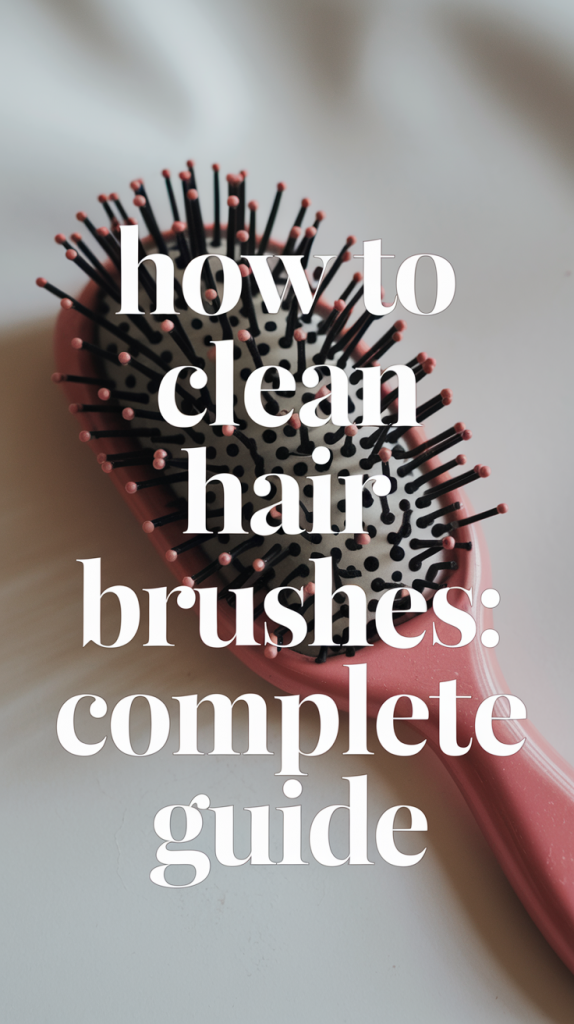How to Clean Hair Brushes: The Ultimate Step-by-Step Guide
Have you ever picked up your hairbrush, only to find it full of tangled hair, product buildup, and lint? Trust me, I’ve been there! Cleaning hairbrushes is often overlooked, but it’s such a crucial step in maintaining healthy, shiny hair. A dirty brush not only spreads grime back onto your freshly washed locks but can also lead to scalp irritation. Let’s fix that today! I’ll guide you through everything you need to know about cleaning hairbrushes, including pro tips and tools to make the process quick and easy.

Why Cleaning Your Hairbrush is Important
Using a dirty hairbrush is like wearing unwashed clothes—it feels off, and it’s far from hygienic! Over time, hairbrushes accumulate oil, dust, and product residue that can:
- Transfer dirt back to your hair, making it look greasy.
- Clog your scalp pores, potentially causing dandruff or irritation.
- Reduce the effectiveness of your styling routine.
By cleaning your brushes regularly, you’ll not only prolong their lifespan but also keep your hair healthier and shinier.
How Often Should You Clean Hairbrushes?
How often you clean your hairbrush depends on how much you use it and your hair care routine. Here’s a handy breakdown:
| Hairbrush Usage | Cleaning Frequency |
|---|---|
| Daily use with products | Weekly |
| Minimal product use | Every 2 weeks |
| Rare use (special occasions) | Monthly |
Pro Tip: Remove loose hair after every use to make deep cleaning easier!
Step-by-Step Guide to Cleaning Hair Brushes

1. Remove Hair from the Brush
Before diving into washing, start by removing all visible hair from the bristles:
- Use your fingers or a comb to pull out the hair.
- For tightly tangled hair, grab a pair of scissors and carefully snip through the knots.
2. Prepare the Cleaning Solution
Create a cleaning solution that suits your brush type. Here’s how:
| Brush Material | Best Cleaning Solution |
|---|---|
| Plastic or metal brushes | Warm water + dish soap |
| Natural bristle brushes | Warm water + mild shampoo |
| Wooden brushes | Warm water + vinegar (diluted) |
For extra freshness, add a teaspoon of baking soda to remove stubborn buildup.
3. Soak and Scrub
- Plastic Brushes: Submerge the entire brush in the cleaning solution for 5-10 minutes.
- Wooden Brushes: Dip only the bristles to avoid soaking the handle.
- Use a toothbrush to scrub between bristles and remove residue.
4. Rinse and Dry
- Rinse thoroughly under warm running water to remove all soap or residue.
- Shake off excess water and let the brush air-dry bristle-side down on a clean towel.

Special Cleaning Tips for Different Hairbrush Types
- Electronic Brushes (e.g., Heated or Blow-Dryer Brushes)
Unplug the brush and clean the bristles with a damp cloth. Avoid water near the electronic parts. - Natural Bristle Brushes
These brushes are more delicate. Use a mild shampoo in the cleaning solution and avoid soaking. - Brushes with Padded Bases
Avoid submerging padded brushes. Instead, focus on scrubbing the bristles gently with a damp toothbrush.
Preventing Odor and Mold on Hairbrushes
If your brush smells musty or shows signs of mold, you can sanitize it with vinegar:
- Mix one part vinegar with three parts water.
- Dip the bristles into the solution for 10 minutes.
- Rinse thoroughly and dry completely.
Storage and Maintenance Tips
To keep your hairbrushes cleaner for longer:
- Store them in a dry, dust-free area.
- Use a protective cover when traveling.
- Clean your brush at the first sign of lint or buildup.
FAQs
1. Why is there lint in my hairbrush?
Lint comes from a mix of dust, dead skin cells, and product buildup. Regular cleaning prevents this accumulation.
2. Can I use natural ingredients to clean my hairbrush?
Yes! Vinegar, baking soda, and lemon juice are excellent natural cleaners.
3. How do I clean brushes with delicate bristles?
Use a mild shampoo and gently scrub with a soft toothbrush to avoid damaging the bristles.
4. How often should I replace my hairbrush?
Replace your brush every 6-12 months, or sooner if the bristles are damaged.
5. Can I wash my hairbrush in the dishwasher?
While some plastic brushes can withstand the dishwasher, it’s generally better to hand wash to avoid warping.
6. Is it okay to share hairbrushes?
Sharing brushes isn’t recommended as it can transfer oils, bacteria, and debris.
Conclusion
Cleaning your hairbrush doesn’t have to be a chore—it’s a small task with big rewards! By keeping your brushes clean, you’re not only ensuring they last longer but also promoting healthier, shinier hair. So, go ahead and give your trusty tools the love they deserve. You’ll feel the difference the next time you brush your hair. Ready to get started?

